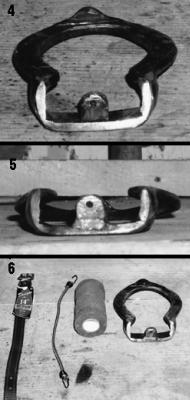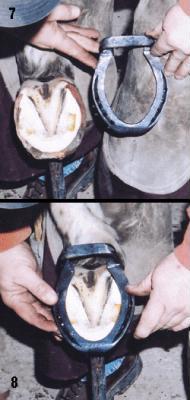With a few precautions and some relatively inexpensive materials, I came up with a method that helps horses with a lacerated deep digital flexor tendon.
It involves using a patten bar shoe and a small bungee cord to function in the place of the tendon.
If the laceration is below the fetlock joint, this apparatus works very well and with much less atrophy and soreness than with most casts or braces that veterinarians often prescribe with a patten bar shoe.
This method has worked well on the hind limb, but has been especially effective on the front leg.
FIGURE 1. A patten bar shoe, with the extension for the bar.
FIGURE 2. A 5/16-by-3/4-inch bar is prepared by drilling a 3/16-inch hole just 1/4 inch away from the end of the bar.
FIGURE 3. After the hole is drilled, round off the corners of the end of the bar stock.
Getting Started
In most front limb applications of the patten bar shoe, the horse tries to use the bar of the shoe as a pivot point if the bar is not extended back considerably. (See "Forging The Patten Bar Shoe," Chris Gregory, American Farriers Journal, December, 2003, Page 84). This method prevents a horse from doing so.
Here's how to put it together. This particular application was performed on the right hind limb.
First, make a patten bar shoe, with the proper extension for the bar (Figure 1). As a rule, I like to leave a little more extension for front limb applications than on hind limb applications. There are several different ways to make the patten bar shoe. You can use a portable welder or hand forge the shoe. I chose to hand forge this shoe to help hone my skills.
Mark a piece of 5/16-by-3/4-inch bar stock, 3/4 of an inch from the end. Place a center punch mark in 1/4 inch from the end, in the center of the web of the stock (Figure 2). Drill a 3/16-inch hole where you made the center punch mark, and round off the outer corners (Figure 3).
FIGURE 4. After being cut from the bar stock, the piece with an eyelet is welded to the bar of the patten shoe.
FIGURE 5. A eye-level view of the now-welded eyelet piece and its positioning on the patten bar.
FIGURE 6. The materials needed for the deep digital flexor tendon treatment include a 14-inch leather dog collar with a D-ring, a 10-inch bungee cord, some vet wrap and a modified patten bar shoe.
Cut off the 3/4-inch piece with the hole in it. Place it in the center of the bar on the outer edge of the shoe. If there is a toe clip on the shoe, sight across and line up this piece with the toe clip (Figure 4). With a small Mig welder or arc welder, weld the piece to the bar with the hole facing up.
You should now have a finished shoe with an eyelet welded in line with the clip (Figure 5). Now you'll need a 14-inch leather dog collar with a sewn-in D-ring (assuming you're building this for a regular saddle horse). You'll also need a small, 10-inch bungee cord (a package of six cost me just $1.97 at Wal-Mart) and some vet wrap (Figure 6).
For extra padding — which I recommend for a full 4-week application — you may want to add a cotton wrap and a polo wrap.
Now, properly trim the foot and hot fit the shoe for a rocker toe and clip if needed (Figure 7). Align the shoe properly with the bony column (Figure 8).
After nailing on the finished shoe, you're ready to add what I call a deep digital bungee tendon. Apply the gauze or cotton padding and vet wrap just above the fetlock joint. This is also a good time to apply a thin polo wrap for extra padding (Figure 9).
Apply the dog collar with the D-ring in the center of the hind portion of the leg, directly above the eyelet of the shoe. Be careful not to tighten the collar too tight; only a semi-snug fit is required.
FIGURE 7. The freshly-trimmed foot is ready for a hot fitting of the patten bar shoe.
FIGURE 8. The shoe must be set in proper alignment with the coffin bone.
The Bungee Tendon
Now you're ready for the bungee cord. Hook one end of the bungee cord in the eye of the bar. Bring the cord up and through the D-ring on the collar, then back down through the hook on the other end in the eyelet of the bar (Figure 10).
You now have the finished application, complete with padding, dog collar, bungee tendon and patten shoe.
As Chris Gregory noted in his December article, patten bar shoes are meant for rest, and so is this adaptation. Most of these shoes are used for about 3 to 4 weeks, or until the horse can be safely lowered in angle with a more conventional shoe. After 3 to 4 weeks, the tendons were healed enough to discard the apparatus and continue with less severe methods.
FIGURE 9. Gauze or cotton padding, overlayed by vet wrap, is applied just above the fetlock joint. A polo wrap may be added for extra padding.
FIGURE 10. (Rear view and side view). Place the dog collar around the padding, no tighter than semi-snug, with the D-ring to the rear. Hook one end of the bungee cord to the eyelet, then run the cord up and through the D-ring, then downward to hook the second end of the cord to the eyelet. Expect the horse to need a few minutes to adapt to the apparatus.











Post a comment
Report Abusive Comment